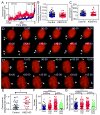The tetrameric kinesin Kif25 suppresses pre-mitotic centrosome separation to establish proper spindle orientation
- PMID: 28263957
- PMCID: PMC5376238
- DOI: 10.1038/ncb3486
The tetrameric kinesin Kif25 suppresses pre-mitotic centrosome separation to establish proper spindle orientation
Erratum in
-
Corrigendum: The tetrameric kinesin Kif25 suppresses pre-mitotic centrosome separation to establish proper spindle orientation.Nat Cell Biol. 2017 May 31;19(6):740. doi: 10.1038/ncb3546. Nat Cell Biol. 2017. PMID: 28561052 No abstract available.
Abstract
Microtubules tether centrosomes together during interphase. How this is accomplished and what benefit it provides to the cell is not known. We have identified a bipolar, minus-end-directed kinesin, Kif25, that suppresses centrosome separation. Kif25 is required to prevent premature centrosome separation during interphase. We show that premature centrosome separation leads to microtubule-dependent nuclear translocation, culminating in eccentric nuclear positioning that disrupts the cortical spindle positioning machinery. The activity of Kif25 during interphase is required to maintain a centred nucleus to ensure the spindle is stably oriented at the onset of mitosis.
Conflict of interest statement
The authors declare no competing financial interests.
Figures





Comment in
-
Cell Division: Centrosomes Have Separation Anxiety.Curr Biol. 2017 Jun 19;27(12):R601-R603. doi: 10.1016/j.cub.2017.04.050. Curr Biol. 2017. PMID: 28633031
Similar articles
-
The balance between KIFC3 and EG5 tetrameric kinesins controls the onset of mitotic spindle assembly.Nat Cell Biol. 2019 Sep;21(9):1138-1151. doi: 10.1038/s41556-019-0382-6. Epub 2019 Sep 2. Nat Cell Biol. 2019. PMID: 31481795
-
Cell Division: Centrosomes Have Separation Anxiety.Curr Biol. 2017 Jun 19;27(12):R601-R603. doi: 10.1016/j.cub.2017.04.050. Curr Biol. 2017. PMID: 28633031
-
Mammalian RanBP1 regulates centrosome cohesion during mitosis.J Cell Sci. 2003 Aug 15;116(Pt 16):3399-411. doi: 10.1242/jcs.00624. Epub 2003 Jul 2. J Cell Sci. 2003. PMID: 12840069
-
Dynamic changes in nuclear architecture during mitosis: on the role of protein phosphorylation in spindle assembly and chromosome segregation.Exp Cell Res. 1996 Dec 15;229(2):174-80. doi: 10.1006/excr.1996.0356. Exp Cell Res. 1996. PMID: 8986594 Review.
-
Positioning centrosomes and spindle poles: looking at the periphery to find the centre.Biol Cell. 2006 Sep;98(9):557-65. doi: 10.1042/BC20060017. Biol Cell. 2006. PMID: 16907664 Review.
Cited by
-
The structure and function of centriolar rootlets.J Cell Sci. 2021 Aug 15;134(16):jcs258544. doi: 10.1242/jcs.258544. Epub 2021 Aug 18. J Cell Sci. 2021. PMID: 34405868 Free PMC article.
-
Involvement of kinesins in skeletal dysplasia: a review.Am J Physiol Cell Physiol. 2024 Aug 1;327(2):C278-C290. doi: 10.1152/ajpcell.00613.2023. Epub 2024 Apr 22. Am J Physiol Cell Physiol. 2024. PMID: 38646780 Free PMC article. Review.
-
Kinesin KIFC3 is essential for microtubule stability and cytokinesis in oocyte meiosis.Cell Commun Signal. 2024 Mar 29;22(1):199. doi: 10.1186/s12964-024-01589-8. Cell Commun Signal. 2024. PMID: 38553728 Free PMC article.
-
Involvement of Kif4a in Spindle Formation and Chromosome Segregation in Mouse Oocytes.Aging Dis. 2018 Aug 1;9(4):623-633. doi: 10.14336/AD.2017.0901. eCollection 2018 Aug. Aging Dis. 2018. PMID: 30090651 Free PMC article.
-
Discovery of high-confidence human protein-coding genes and exons by whole-genome PhyloCSF helps elucidate 118 GWAS loci.Genome Res. 2019 Dec;29(12):2073-2087. doi: 10.1101/gr.246462.118. Epub 2019 Sep 19. Genome Res. 2019. PMID: 31537640 Free PMC article.
References
-
- Jean C, Tollon Y, Raynaud-Messina B, Wright M. The mammalian interphase centrosome: two independent units maintained together by the dynamics of the microtubule cytoskeleton. Eur J Cell Biol. 1999;78:549–560. - PubMed
-
- Saunders WS, Hoyt MA. Kinesin-related proteins required for structural integrity of the mitotic spindle. Cell. 1992;70:451–458. - PubMed
MeSH terms
Substances
Grants and funding
LinkOut - more resources
Full Text Sources
Other Literature Sources
Molecular Biology Databases

